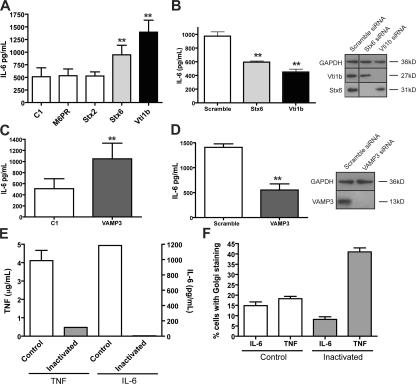Figure 7.
SNARE and recycling endosomes in the trafficking and secretion of IL-6. (A–F) Exocytic trafficking was altered in macrophages by the overexpression of specific SNAREs (A and C), their knockdown by specific siRNA (B and D), or by HRP inactivation of the endocytic compartment (E and F). After transfection or treatments, the macrophages were activated with LPS and IFN, the medium was collected 2 h and 6 h after stimulation, and the levels of IL-6 and/or TNFα, respectively, were determined by cytokine-specific ELISAs. (A and C) Overexpression of Stx6, Vti1b, and VAMP3 but not Stx2 led to increased levels of IL-6 secretion from macrophages. Bar graphs represent means ± SEM (error bars) of triplicate transfections. (B and D) Targeted knockdown of the Q-SNAREs Vti1b, Stx6, and VAMP3 by siRNA resulted in significant decreases in the level of IL-6 secreted from activated macrophages. Lysates of macrophages subjected to siRNA knockdown were blotted for Vti1b, Stx6, VAMP3, and the loading control protein glyceraldehyde-3-phoshphate dehydrogenase (GAPDH). Bar graphs represent mean ± SEM of triplicate siRNA transfections. (E) HRP inactivation of the endosomal compartment as described in Materials and methods blocked the secretion of both TNFα and IL-6. (F) In addition, after 6 h of stimulation, coverslips were fixed, stained for intracellular TNFα and IL-6, and the percentage of cells expressing each cytokine was determined. 10 low magnification images were captured per assay condition, each containing at least 50 cells, and the percentage of cells producing TNFα and/or IL-6 was calculated (D). Bar graphs represent mean percentages ± SEM of the individual images captured. **, P < 0.05.

